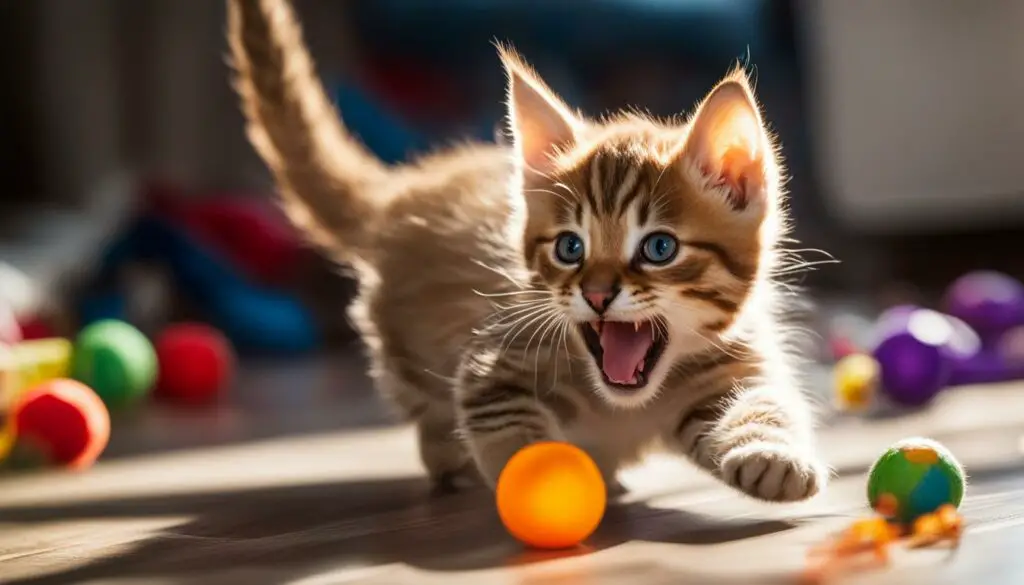Have you ever wondered why your kitten gets so aggressive during playtime? It’s not uncommon for kittens to display aggressive behavior when engaging in play. Understanding the reasons behind this aggression is key to managing and preventing any potential harm.
Kittens are naturally curious and have strong stalking and hunting instincts. To them, moving objects can be seen as threats or prey. This can trigger their aggression during play, as they pounce, bite, and chase after their toys (or even your hands and feet!). But aggression can also be caused by fear, territorial protection, or redirected aggression.
As a responsible pet owner, it’s important to address and manage this aggression to ensure a safe and enjoyable playtime environment for both you and your kitten. By understanding the different types of aggression in kittens, recognizing their body language, and identifying common triggers, you can take the necessary steps to redirect their behavior and foster a healthier play dynamic.
Key Takeaways:
- Aggression during play is common in kittens due to their strong hunting instincts and perceived threats.
- Kitten aggression can be categorized into different types, including fear, play, territorial, and aggression due to pain or illness.
- Recognizing aggressive body language in kittens can help in understanding when intervention is needed.
- Common triggers for aggressive behavior in kittens include movement, hands and feet, other animals, and small children.
- There are various strategies to address and manage aggressive kitten behavior, including behavior modification, interactive play sessions, and providing a consistent playtime routine.
The Different Types of Aggression in Kittens
Aggression in kittens can manifest in various forms, each with its own underlying reasons. Understanding these different types of aggression is essential for effectively addressing and managing the behavior. The following are the four main categories of aggression commonly observed in kittens:
- Fear aggression: When a kitten feels threatened or anxious, it may display aggression as a defensive response. This type of aggression is often triggered by unfamiliar people, animals, or environments.
- Play aggression: Kittens have abundant energy and natural hunting instincts, which can result in overly rough play behaviors. Play aggression usually involves stalking, biting, scratching, and pouncing on people, other animals, or objects.
- Territorial aggression: Kittens may become possessive of their designated territory and exhibit aggression towards perceived intruders or threats to their space. This aggression is often accompanied by marking behaviors such as spraying urine.
- Pain or illness-related aggression: If a kitten is in discomfort or experiencing pain due to an underlying medical condition, it may display aggression as a response to protect itself from further discomfort or perceived threats.
By identifying the specific type of aggression displayed by a kitten, pet owners can tailor their approach to effectively manage and address the behavior. It is important to note that aggressive behavior in kittens should never be ignored or dismissed, as it can escalate and pose potential risks to both humans and other animals in the household.
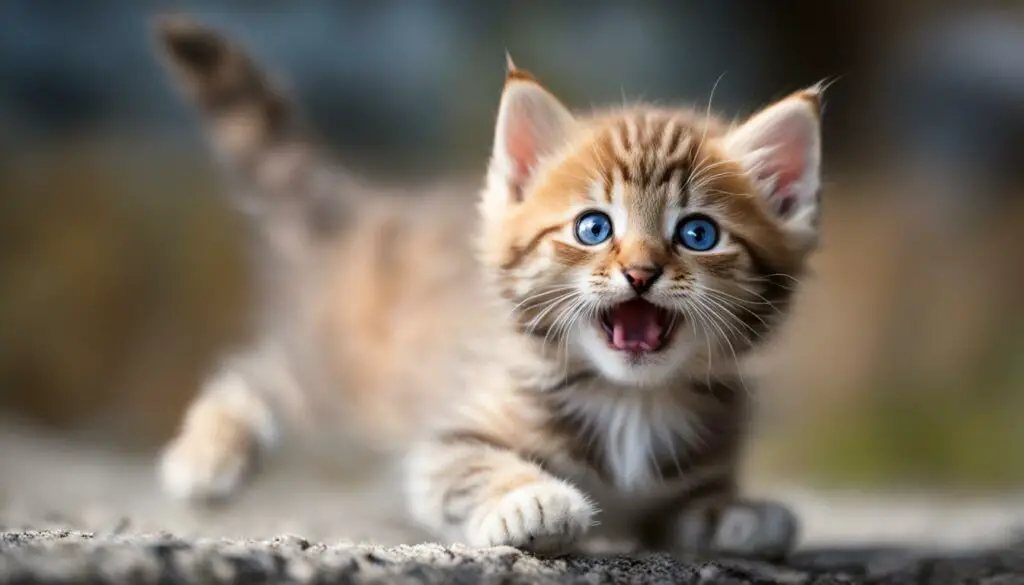
To gain a deeper understanding of the different types of aggression in kittens, let’s delve into each category and explore the underlying reasons and potential triggers associated with each type.
Recognizing Aggressive Body Language in Kittens
When it comes to playtime with kittens, it’s important to understand their body language to differentiate between harmless play and aggressive behavior. Kittens display various signs that indicate aggressive play, allowing us to intervene and prevent any potential escalation.
Kittens engaging in aggressive play often exhibit stalking and hunting postures. They might assume an alert stance, with their bodies lowered and their eyes focused on their target. They may also make stealthy movements, creeping closer to their prey before pouncing. These behaviors mimic their natural instinct to hunt and capture prey.
Twitching, meowing, and tail swatting are additional indications of aggressive play in kittens. These actions are part of their hunting behavior, as they try to mimic the movements of their prey. Furthermore, kittens may arch their backs in a bluffing display, making themselves appear larger and more threatening.
Recognizing these aggressive body language signals is essential for ensuring the safety of both the kitten and anyone involved in playtime. By understanding these behaviors, we can intervene when necessary and redirect their play towards more appropriate and non-aggressive forms.
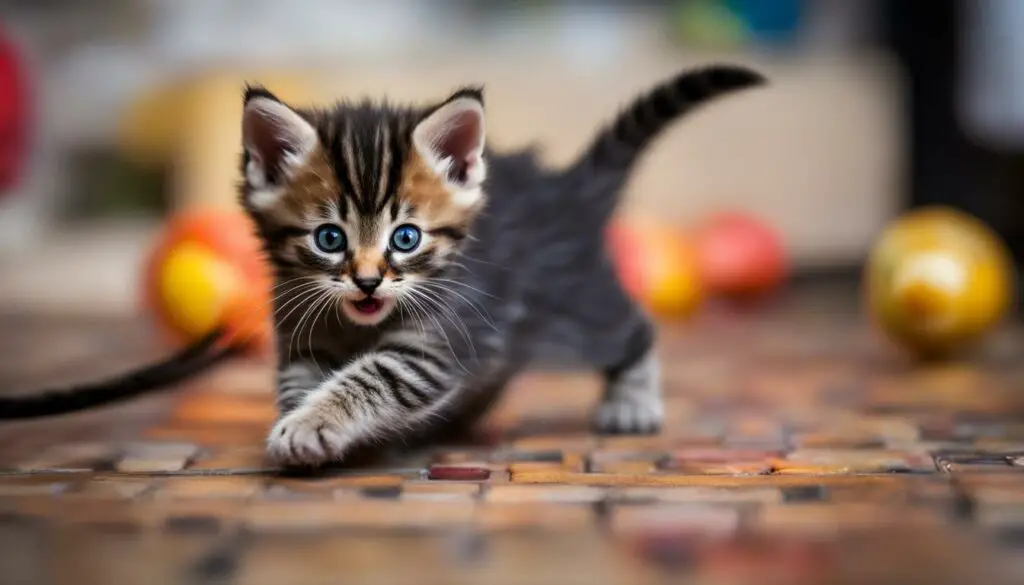
Table: Recognizing Aggressive Body Language in Kittens
| Body Language Signs | Description |
|---|---|
| Stalking posture | Kitten assumes an alert stance, with lowered body and focused eyes. |
| Stealthy movements | Kitten makes slow, calculated movements, creeping closer to their target. |
| Lunging or springing | Kitten pounces or leaps towards their prey. |
| Twitching, meowing, and tail swatting | Kitten displays hunting behaviors to mimic their prey. |
| Arched back | Kitten raises their back in a bluffing display, appearing larger and more threatening. |
Conclusion
Understanding the body language of kittens during play is crucial for differentiating between aggressive play and harmless behavior. By recognizing the signs of aggressive play, such as stalking, stealthy movements, and hunting behaviors, we can intervene appropriately and redirect their play towards more suitable alternatives. This ensures the safety and well-being of both the kitten and those involved in playtime.
Common Triggers for Aggressive Kitten Behavior
Understanding what triggers aggressive behavior in kittens is essential for effectively managing their playtime. Here are some common triggers that can make a kitten aggressive:
- Movement: Any kind of movement, whether it’s walking or picking up an object, can provoke a kitten’s instinct to attack. They may view hands and feet as moving prey objects, leading to aggressive attacks on their owners.
- Presence of other animals or small children: Kittens may perceive the presence of other animals or small children as threats or interlopers in their territory, triggering aggressive behavior as a form of territorial protection.
To create a visually engaging representation of the common triggers for aggressive kitten behavior, here’s a table showcasing these triggers:
| Triggers | Description |
|---|---|
| Movement | Any kind of movement can provoke a kitten’s instinct to attack, perceiving hands and feet as moving prey objects. |
| Presence of other animals or small children | Kittens may view the presence of other animals or small children as threats or interlopers, triggering territorial aggression. |
By identifying these triggers, you can better manage and redirect your kitten’s behavior during playtime, creating a safe and enjoyable environment for both you and your furry friend.
Addressing Aggressive Kitten Behavior
Managing kitten aggression can be a challenge, but with the right strategies, it can be effectively addressed. Here are some techniques to help you stop aggressive kitten behavior during play:
1. Provide alternative outlets for energy:
Kittens have high energy levels, and if they don’t have appropriate outlets for their play behaviors, they may become aggressive during playtime. Provide them with interactive toys, scratching posts, and climbing structures to redirect their energy. Engaging in regular interactive play sessions can also help burn off excess energy and prevent aggression.
2. Use positive reinforcement:
Positive reinforcement is a powerful tool in modifying behavior. When your kitten displays appropriate play behavior, reward them with treats, praise, or extra playtime. This will reinforce their good behavior and encourage them to continue playing without aggression. However, be sure to avoid using punishment or negative reinforcement, as it may escalate aggressive behavior.
3. Interrupt aggressive behavior:
If your kitten becomes too rough during play, it’s important to intervene and redirect their behavior. You can gently say “no” and withdraw your attention. Alternatively, you can use a noise or a spray bottle filled with water (avoiding the face) to interrupt their play and redirect their attention to appropriate toys.
| Techniques to Address Aggressive Kitten Behavior | Benefits |
|---|---|
| Provide alternative outlets for energy | Redirects their play behavior and prevents aggression |
| Use positive reinforcement | Encourages appropriate play behavior and strengthens the bond |
| Interrupt aggressive behavior | Teaches them that aggression doesn’t lead to continued play |
Remember, managing kitten aggression takes time and patience. Consistency in implementing these techniques is key to ensuring a safe and enjoyable playtime with your furry friend. If the aggression persists or worsens, it’s important to seek the advice of a veterinarian or a professional animal behaviorist.

Tips for Safe and Healthy Playtime with Kittens
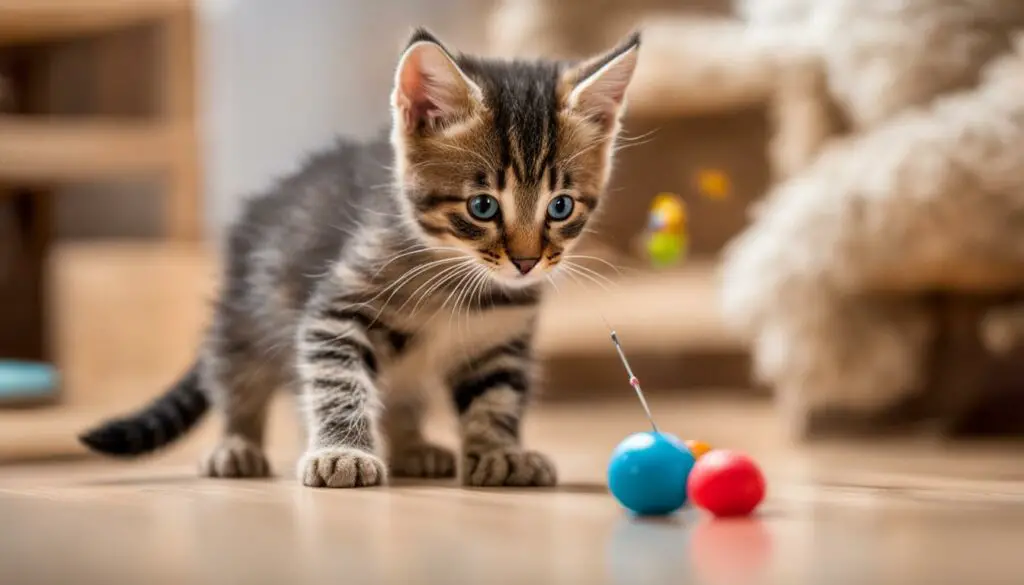
When it comes to playtime with kittens, safety and fun go hand in hand. Here are some tips to ensure that you and your furry friend have a safe and healthy play experience:
- Choose the right toys: Opt for interactive toys that mimic prey and engage your kitten’s hunting instincts. Avoid using your hands as toys to prevent them from associating hands with play aggression.
- Set boundaries: Teach your kitten appropriate play behavior by consistently using toys and redirecting their attention when play becomes too rough. Be patient and reinforce good manners with treats and praise.
- Establish a play routine: Regular play sessions help burn off excess energy and prevent boredom, which can lead to aggression. Set aside dedicated time each day for interactive play with your kitten.
- Provide a safe environment: Create a cat-friendly space with hiding spots and perches where your kitten can retreat and feel secure. This can help reduce anxiety-driven aggression.
By following these tips, you can promote safe and enjoyable playtime with your kitten while minimizing the risk of aggressive behavior. Remember to always monitor your kitten during play and seek professional help if needed.
The Importance of Socialization and Playmates for Kittens
Socialization and playmates play a vital role in managing kitten aggression and promoting their overall well-being. By providing opportunities for positive interactions with humans and other cats, we can help kittens develop appropriate behaviors and learn valuable social skills. Introducing a second kitten of similar age, size, and temperament can be particularly beneficial as it provides a playmate for them to engage with and teaches them bite and claw inhibition.
The presence of playmates helps kittens learn appropriate play behaviors and reduces the likelihood of directed aggression towards humans. Through interactive play with their playmates, kittens develop important social bonds, learn how to communicate through body language, and establish boundaries. These interactions not only help them burn off excess energy but also provide mental stimulation and outlets for their natural instincts.
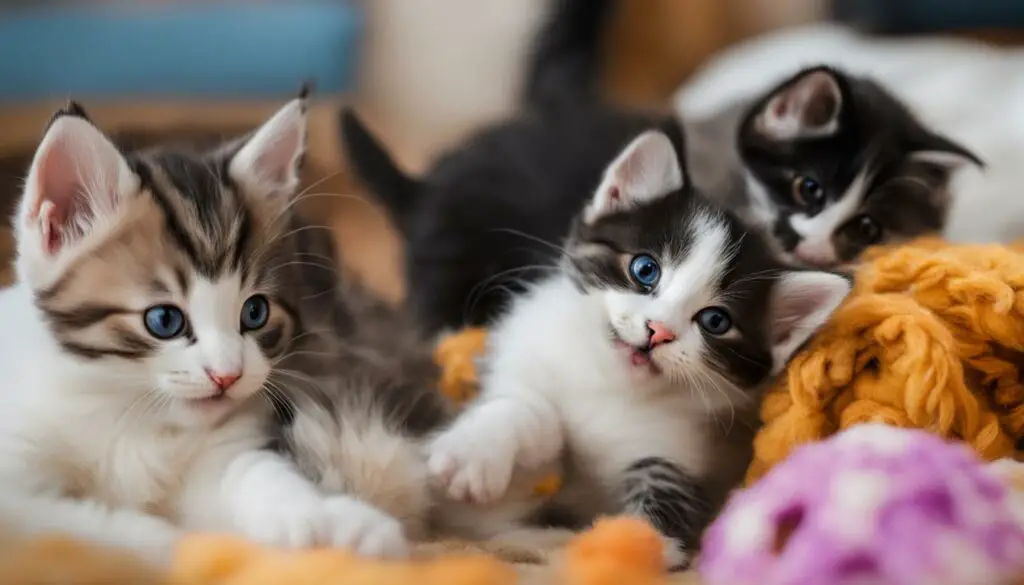
Creative Ways to Facilitate Socialization and Play
To promote socialization and provide enriching play experiences for kittens, try incorporating the following strategies:
- Arrange playdates with other friendly and vaccinated cats to allow positive interactions and shared playtime.
- Create a safe and stimulating environment with plenty of vertical spaces, hiding spots, and scratching posts for exploring and territorial marking.
- Rotate toys regularly to maintain their interest and prevent boredom. Toys that encourage mental stimulation, such as puzzle toys or treat-dispensing toys, can be particularly engaging.
- Engage in interactive play sessions with your kittens using fishing pole toys or toys that imitate prey, allowing them to exhibit their natural hunting behaviors.
- Provide opportunities for guided exploration, such as supervised outdoor play in a secure area or using a cat-friendly harness and leash for walks.
By incorporating these strategies into your kitten’s routine, you can help them develop into well-adjusted and socially adept cats, while also minimizing the occurrence of aggressive behaviors.
Section 8: The Role of Physical and Mental Stimulation in Managing Aggression
Providing physical and mental stimulation is crucial in managing and preventing aggression in kittens. By engaging their natural instincts and keeping them mentally and physically active, you can redirect their energy towards appropriate behaviors. This not only helps in preventing aggressive behavior but also promotes their overall well-being.
Physical exercise is an essential component of managing aggression in kittens. Regular interactive play sessions, using toys that mimic prey or encourage chasing and pouncing, can help burn off excess energy. Incorporating climbing structures and scratching posts provides outlets for their natural behaviors and helps keep their claws and muscles healthy.
Mental stimulation is equally important for kittens. Puzzle toys that dispense treats or require problem-solving can keep their minds engaged and prevent boredom. Training sessions, where they learn simple tricks and commands, can provide mental challenges and strengthen the bond between you and your kitten.
Incorporating a combination of physical and mental stimulation into your kitten’s daily routine can significantly reduce aggression and create a healthy and well-balanced environment for them to thrive.
| Benefits of Physical and Mental Stimulation |
|---|
| Prevents boredom and destructive behavior |
| Reduces stress and anxiety |
| Helps in channeling energy towards appropriate behaviors |
| Improves overall physical and mental well-being |
| Strengthens the bond between you and your kitten |
Remember to provide a variety of toys and activities to keep your kitten engaged and stimulated. Rotate toys regularly to maintain their interest, and always supervise playtime to ensure their safety. By prioritizing physical and mental stimulation, you can create a happy and harmonious environment for your kitten, reducing the likelihood of aggressive behavior and promoting their overall development.
When to Seek Veterinary Help for Aggressive Kitten Behavior
If aggressive behavior in your kitten persists despite your efforts to manage and redirect it, it may be time to seek veterinary help. While kittens can display aggressive behavior due to natural instincts and playfulness, persistent aggression could be a sign of underlying medical conditions. Consulting a veterinarian can help rule out any health issues that may be causing or exacerbating the aggression.
Some medical conditions that can contribute to aggression in kittens include hyperthyroidism, osteoarthritis, dental disease, and central nervous system problems. These conditions can cause sudden changes in behavior and aggression. A thorough examination by a veterinarian, including blood work and diagnostic tests, can help identify any underlying health issues and determine the best course of action.
Your veterinarian may recommend treatment options such as medication, dietary changes, or behavioral therapy to address the underlying medical condition and help manage the aggressive behavior. They can also provide guidance on behavior modification techniques specific to your kitten’s needs and help you create a customized plan to address the aggression.
Signs to Look for:
If you’re unsure whether your kitten’s aggression warrants veterinary attention, here are some signs to look for:
- Sudden or extreme aggression
- Aggression that is not play-related
- Inability to redirect or modify aggressive behavior
- Aggression that results in injury to people or other animals
- Changes in behavior, appetite, or litter box usage
“Persistent aggression in kittens could indicate underlying medical conditions. Seeking veterinary help is crucial to rule out health issues and develop a tailored treatment plan.” – Dr. Jane Smith, Veterinarian
| Medical Condition | Symptoms |
|---|---|
| Hyperthyroidism | Increased appetite, weight loss, restlessness |
| Osteoarthritis | Limping, difficulty jumping, stiffness |
| Dental Disease | Bad breath, reluctance to eat, drooling |
| Central Nervous System Problems | Seizures, loss of coordination, behavior changes |
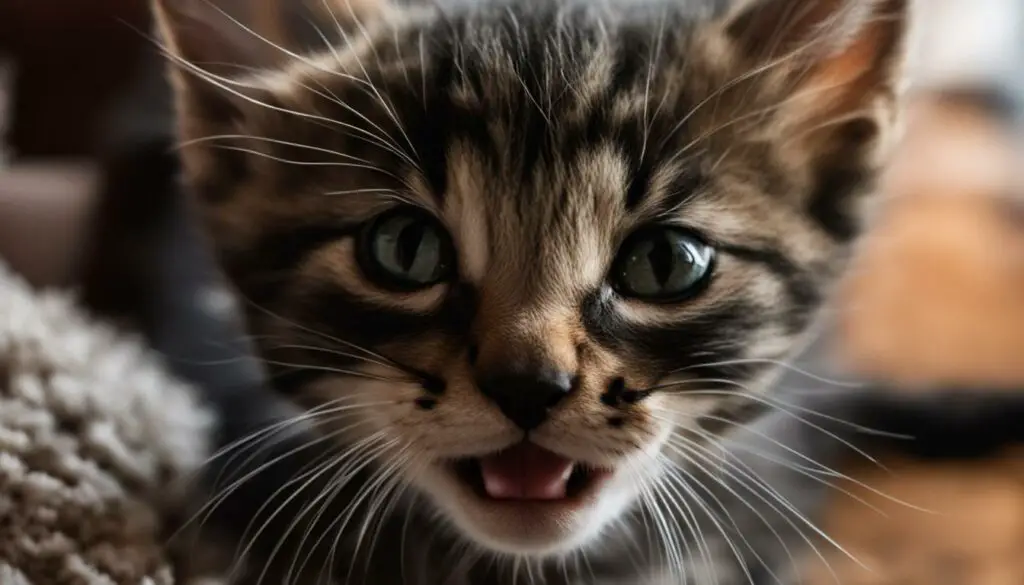
The Role of Neutering and Spaying in Reducing Aggression
Spaying or neutering kittens before their first birthday can have a significant impact on reducing aggression, particularly in cat-on-cat interactions. This procedure helps regulate their hormones and can decrease aggressive behavior, making it an important consideration for cat owners.
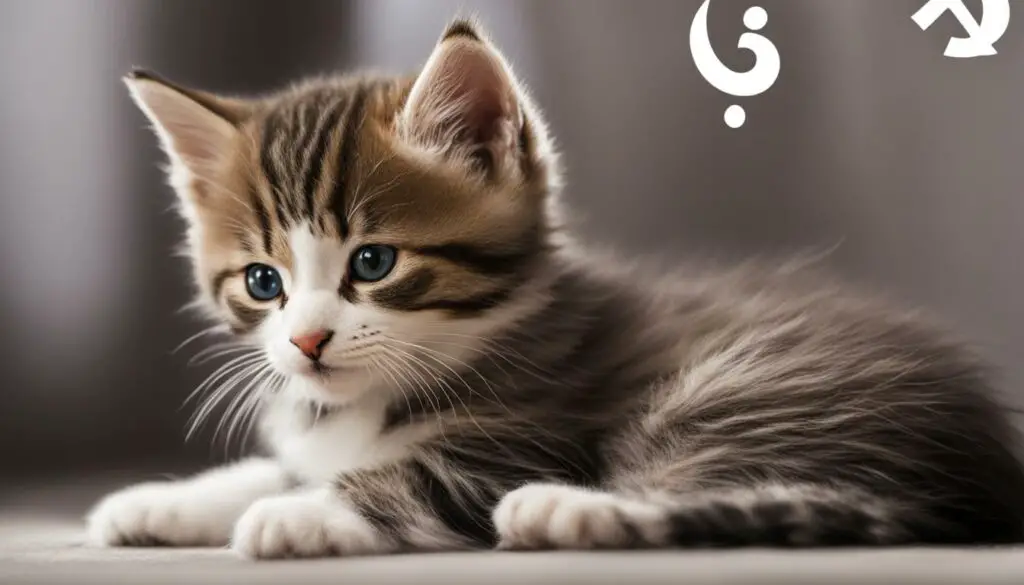
Neutering male cats can be particularly effective in reducing territorial disputes and fights. Without the influence of testosterone, neutered males are generally more calm and less likely to engage in aggressive behaviors.
“Spaying or neutering kittens at the appropriate age can greatly contribute to managing their aggression and promoting harmonious interactions with other cats.”
The Effect of Spaying/Neutering on Cat-on-Cat Aggression
A study conducted by the American Society for the Prevention of Cruelty to Animals (ASPCA) found that spayed or neutered cats were less likely to engage in aggressive behaviors towards other cats. The study concluded that the reduction in aggression is primarily due to the absence of reproductive hormones, which can contribute to territorial disputes and dominance-related aggression.
To ensure the best results, it is recommended to spay or neuter kittens before they reach sexual maturity. This typically occurs around six months of age. However, consult with your veterinarian to determine the most appropriate timing for your kitten based on their specific development and health.
| Benefits of Spaying/Neutering in Reducing Aggression: | Effectiveness: |
|---|---|
| Reduces cat-on-cat aggression | Highly effective in most cases |
| Decreases territorial disputes | Significantly reduces occurrence |
| Prevents dominance-related aggression | Effective in curbing such behavior |
Overall, spaying or neutering kittens can have long-term positive effects on reducing aggression and promoting a more harmonious environment for multiple cats.
Additional Strategies for Managing and Preventing Aggression
When it comes to managing and preventing aggression in kittens, there are several additional strategies that can be effective. These strategies aim to create a positive and safe environment for your kitten, promoting healthy behaviors and minimizing aggressive tendencies. Here are some additional methods you can try:
Create a structured playtime routine:
Establishing a consistent playtime routine can help channel your kitten’s energy in a controlled manner. Set aside dedicated play sessions each day to engage your kitten in interactive play using appropriate toys. This will provide an outlet for their natural hunting instincts and prevent excessive aggression.
Provide plenty of mental stimulation:
Kittens need mental stimulation to keep their minds sharp and prevent boredom-related aggression. Incorporate puzzle toys, treat-dispensing toys, and scratching posts into their environment to provide mental challenges and outlets for natural behaviors. This will help keep them engaged and content.
Use positive reinforcement:
Positive reinforcement is a powerful tool in training kittens to play without aggression. Rewarding good behavior with treats, praise, or playtime can reinforce positive associations and encourage gentle play. When your kitten displays aggressive behavior, redirect their attention to a toy and reward them for engaging in appropriate play.
Seek professional help if needed:
If your kitten’s aggression persists or escalates despite your efforts, it may be beneficial to seek professional help from a veterinarian or animal behaviorist. They can provide guidance tailored to your specific situation and help address any underlying causes of aggression.
| Additional Strategies for Managing and Preventing Aggression |
|---|
| Create a structured playtime routine |
| Provide plenty of mental stimulation |
| Use positive reinforcement |
| Seek professional help if needed |
The Importance of Play and Bonding with Your Kitten
Playtime is not only essential for managing aggression but also for strengthening the bond between you and your kitten. Engaging in interactive play sessions allows you to spend quality time together, creating positive associations and building trust. “Playing with your kitten is a fantastic way to bond and build a strong relationship”. Using play as a means of bonding can help kittens feel more connected to you and decrease the likelihood of aggression directed towards you.
It’s important to remember that playtime should be a positive experience for both you and your kitten. Choose toys that stimulate their natural instincts and allow them to showcase their hunting skills. Incorporating toys that mimic prey and using interactive toys, such as fishing pole toys, can keep your kitten engaged and active. Remember to always use toys and avoid using your hands as play objects to prevent them from associating hands with play aggression.
Creating a play routine with your kitten can help establish a sense of structure and consistency. Set aside dedicated time each day for play sessions, making sure to provide mental and physical stimulation. By being present during playtime, you can actively observe and understand your kitten’s behavior, allowing you to address any signs of aggression or rough play. “Playing together not only strengthens the bond between you and your kitten but also provides an outlet for their energy and natural instincts”.
| Type of Play | Benefits |
|---|---|
| Interactive play with toys | Stimulates hunting instincts, provides exercise, and strengthens the bond |
| Training sessions | Enhances mental stimulation, improves obedience, and reinforces positive behaviors |
| Social play with other kittens or cats | Teaches proper socialization skills, encourages play and exercise, and reduces aggression towards humans |
Remember, playtime should be a positive and safe experience for both you and your kitten. Observe their body language and adjust the intensity of play accordingly. If your kitten becomes too rough or aggressive during play, redirect their attention to appropriate toys and reward calm behavior. By incorporating play into your daily routine, you can build a strong bond with your kitten and create a loving and harmonious environment.
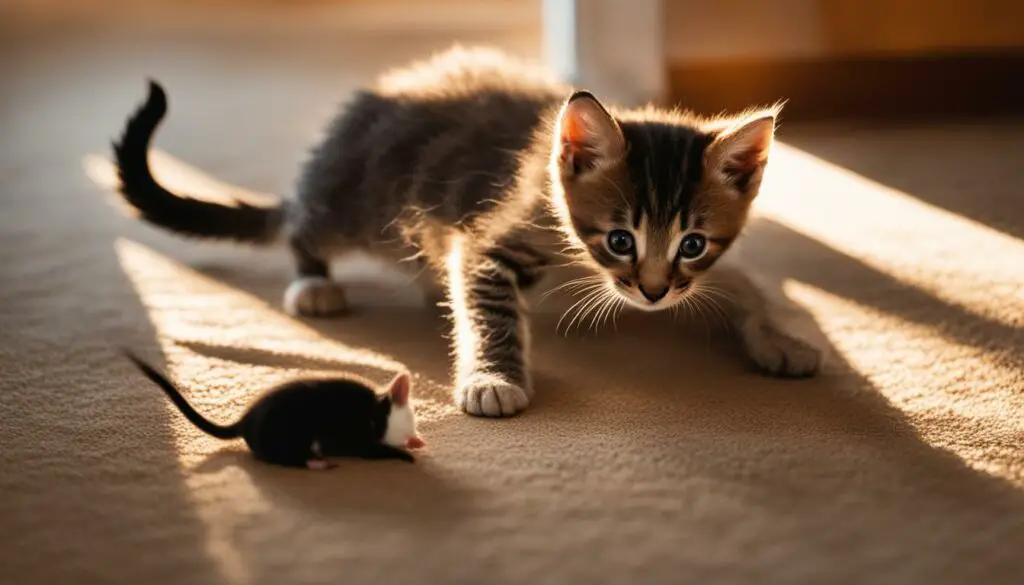
Understanding Play Aggression in Older Cats
Play aggression is not limited to kittens; older cats can also exhibit this behavior. While it may seem unusual for adult cats to engage in play aggression, it is often the result of high energy levels and a lack of appropriate outlets for play. Understanding and managing play aggression in older cats is important to ensure their well-being and prevent any potential harm.
One way to address play aggression in older cats is by providing regular and interactive play sessions. Engaging your cat in play helps burn off excess energy and stimulates their natural hunting instincts. Interactive toys, such as fishing pole toys or laser pointers, can be used to redirect their play aggression towards appropriate targets. Additionally, incorporating puzzle toys or treat-dispensing toys can provide mental stimulation and help keep them mentally engaged.
It is also important to create an enriched environment for your cat. This includes providing scratching posts, climbing structures, and hiding spots. These items allow your cat to engage in natural behaviors and provide them with outlets for their energy. Additionally, having multiple vertical spaces, such as cat trees or shelves, can help create a sense of territory and reduce territorial aggression.
| About Play Aggression in Older Cats | Tips for Managing Play Aggression in Older Cats |
|---|---|
| 1. Play aggression in older cats is usually a result of high energy levels and a lack of appropriate play outlets. | 1. Provide regular and interactive play sessions to burn off excess energy and stimulate their natural hunting instincts. |
| 2. Interactive toys, such as fishing pole toys or laser pointers, can be used to redirect play aggression towards appropriate targets. | 2. Incorporate puzzle toys or treat-dispensing toys to provide mental stimulation and keep them mentally engaged. |
| 3. Creating an enriched environment with scratching posts, climbing structures, and hiding spots can provide outlets for their energy. | 3. Have multiple vertical spaces, such as cat trees or shelves, to create a sense of territory and reduce territorial aggression. |
By understanding the underlying causes of play aggression in older cats and implementing appropriate strategies, you can effectively manage and redirect their behavior. It is important to remember that patience and consistency are key when addressing play aggression. If you have concerns about your cat’s behavior, consulting with a veterinarian or a professional animal behaviorist can provide additional guidance and support.

The Importance of Play and Mental Stimulation
Playtime and mental stimulation are important aspects of managing play aggression in older cats. Providing opportunities for play allows cats to release their energy and engage in natural behaviors, reducing the likelihood of aggressive play. Mental stimulation, through puzzle toys or training exercises, can also help redirect their energy and keep their minds engaged. By incorporating play and mental stimulation into your cat’s daily routine, you can help them maintain a balanced and healthy lifestyle.
Training and Redirecting Aggressive Play in Kittens
Training kittens to play without aggression is an important part of ensuring a safe and enjoyable playtime experience. By redirecting their aggressive behavior and providing consistent reinforcement, you can help them learn appropriate play manners. One effective technique is to use positive reinforcement. When your kitten exhibits gentle play behavior, reward them with treats, praise, or play rewards. This reinforces the idea that playing gently leads to positive outcomes.
If your kitten becomes too rough during play, it’s essential to end the play session immediately. This teaches them that aggression results in the end of playtime. Redirect their attention to appropriate toys or activities, allowing them to engage their natural hunting instincts in a more controlled manner. Consistency is key when training kittens, so be sure to repeat these techniques consistently to reinforce positive play behavior.
Redirecting aggressive play behavior in kittens is crucial for their development and the safety of those around them. By providing positive reinforcement and redirecting their attention, you can teach them to play in a gentler and more controlled manner. Remember to always prioritize their safety and well-being during playtime.
Additionally, it’s important to create a play environment that encourages appropriate behavior. Offer a variety of interactive toys that mimic prey, allowing your kitten to engage their hunting instincts. Avoid using your hands as toys to prevent them from associating hands with play aggression. Instead, use toys that keep a safe distance between your hands and their teeth and claws.
With patience, consistency, and appropriate training techniques, you can help your kitten develop healthy play habits and build a strong bond between the two of you.
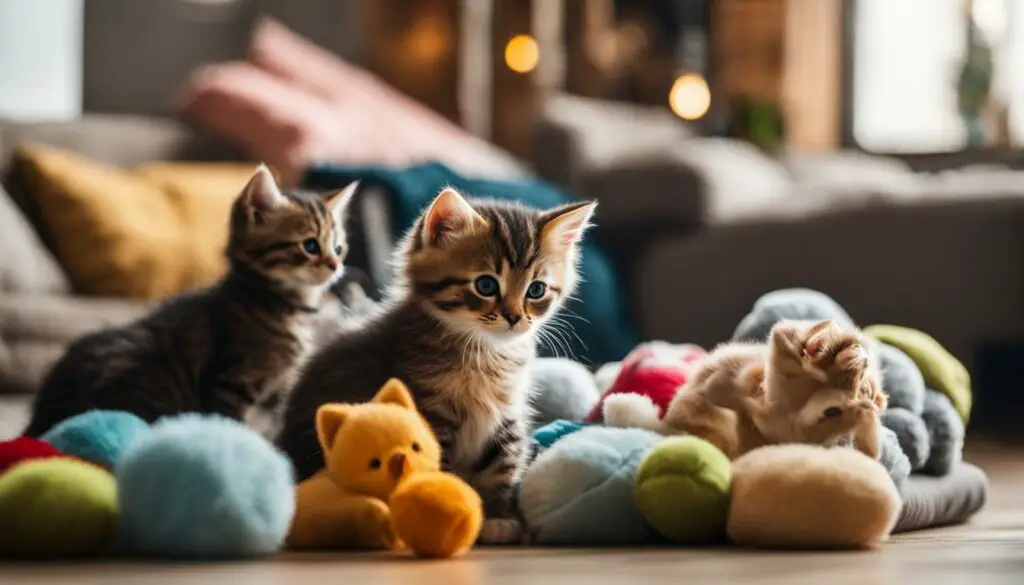
Incorporating Toys and Games for Safe Play with Kittens
When it comes to playing with kittens, choosing safe and appropriate toys is essential for their well-being and enjoyment. Interactive toys that mimic prey are particularly effective in engaging their hunting instincts and providing mental stimulation. One popular option is fishing pole toys, which allow you to control the movement of the toy and entice your kitten to pounce and chase. These toys not only keep your kitten active but also provide a bonding experience between you and your furry friend.
In addition to interactive toys, puzzle toys and treat-dispensing toys are great options to keep your kitten entertained and mentally stimulated. These toys require your kitten to figure out how to access the treats or solve the puzzle, providing hours of entertainment and engaging their problem-solving skills. By rotating and introducing new toys regularly, you can keep their interest and prevent boredom. It’s important to remember that kittens, like children, can quickly lose interest in toys, so keeping their toy collection fresh and exciting is key.
“Interactive toys that mimic prey are particularly effective in engaging their hunting instincts and providing mental stimulation.”
Aside from specific toys, incorporating interactive games into your playtime routine can also enhance the experience for both you and your kitten. Hide-and-seek is a popular game that taps into their natural hunting instincts. Hide treats or toys in different areas of the room and encourage your kitten to find them. You can also play a game of fetch using small, lightweight toys. This not only provides physical exercise but also encourages your kitten to bring back the toy, strengthening the bond between you and your feline companion.
Remember to always supervise your kitten during playtime and choose toys that are size-appropriate and free from small parts that can be chewed or swallowed. Regularly inspect toys for any signs of wear and tear and replace them as needed. By providing a variety of safe and engaging toys and incorporating interactive games into playtime, you can ensure a fun and enriching experience for your kitten while promoting their physical and mental well-being.
Table: Comparison of Safe Toys for Kittens
| Toy Type | Description | Benefits |
|---|---|---|
| Interactive fishing pole toys | Mimics prey movement, enticing kittens to chase and pounce | Engages hunting instincts, provides bonding experience |
| Puzzle toys | Requires problem-solving skills to access treats or solve puzzles | Provides mental stimulation, prevents boredom |
| Treat-dispensing toys | Dispenses treats when manipulated by the kitten | Keeps kittens entertained, encourages problem-solving |
| Hide-and-seek game | Hide treats or toys for the kitten to find | Taps into natural hunting instincts, mental stimulation |
| Fetch with lightweight toys | Kitten retrieves and brings back the toy | Physical exercise, strengthens bond between kitten and owner |
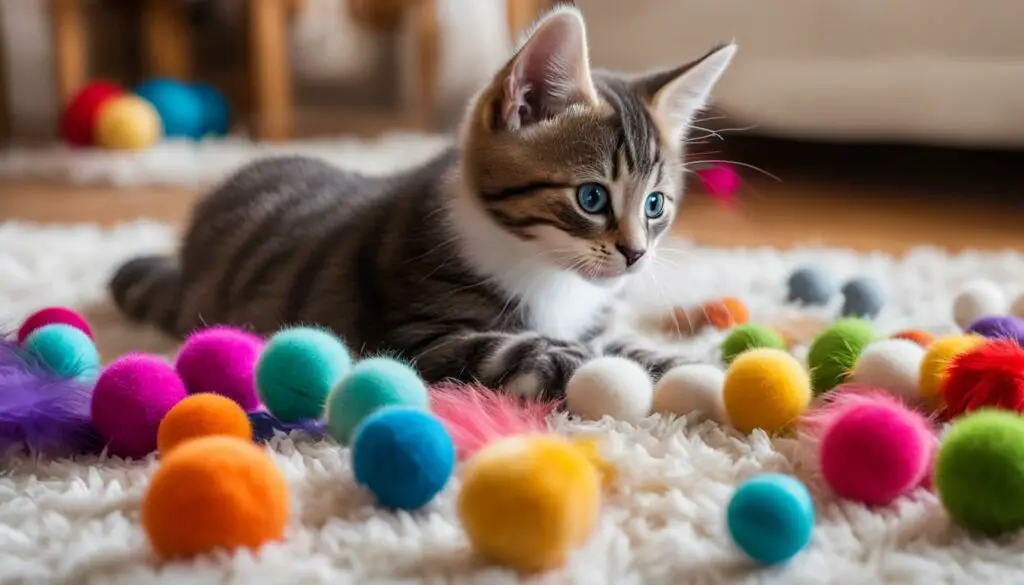
Conclusion
In conclusion, understanding aggressive kitten behavior is essential for creating a safe and enjoyable playtime environment. Kittens may display aggression during play due to their strong stalking and hunting instincts, perceiving moving objects as threats or prey. Different types of aggression in kittens include fear aggression, play aggression, territorial aggression, and aggression due to pain or illness. By recognizing the signs of aggressive body language and identifying common triggers, you can effectively manage and redirect their behavior.
Addressing aggressive kitten behavior involves several strategies, such as ensuring their overall health, using behavior modification techniques, and providing consistent playtime routines. It is important to incorporate tips for safe and healthy playtime, including using interactive toys, avoiding using hands as toys, and training kittens to play appropriately. Socialization and the presence of playmates are crucial in managing aggression, while providing physical and mental stimulation can help prevent aggressive behavior.
If aggressive behavior persists despite your efforts, it is important to seek veterinary help to rule out any underlying medical conditions. Spaying or neutering kittens can also contribute to reducing aggression, especially cat-on-cat aggression. Additional strategies, such as creating positive associations with playtime and maintaining a calm and consistent environment, can help in managing and preventing aggression.
Ultimately, playtime serves as a bonding opportunity with your kitten. By engaging in interactive play sessions and building trust, you can strengthen your bond and decrease the likelihood of aggression directed towards you. Remember to maintain a balance between play and rest and provide an enriched environment for your kitten’s overall well-being.
FAQ
Why is my kitten so aggressive when playing?
Kittens can display aggressive behavior when playing due to fear or playfulness. Their stalking and hunting instincts are strong, causing them to perceive moving objects as threats or prey.
What are the different types of aggression in kittens?
Aggression in kittens can be categorized into fear aggression, play aggression, territorial aggression, and aggression due to pain or illness.
How can I recognize aggressive body language in kittens?
Kittens display specific body language during aggressive play, including stalking postures, alert stances, stealthy movements, and lunging or springing at their target. They may also exhibit twitching, meowing, and tail swatting.
What are common triggers for aggressive kitten behavior?
Kittens can be triggered to engage in aggressive behavior by various factors, including movement, the presence of other animals or small children, and perceived threats to their territory.
How can I address aggressive kitten behavior?
Strategies for addressing aggressive behavior in kittens include ensuring the kitten’s overall health, using behavior modification techniques, providing regular interactive play sessions, and maintaining a consistent playtime routine.
What are some tips for safe and healthy playtime with kittens?
Tips for safe and healthy playtime with kittens include using interactive toys, avoiding using hands as toys, training kittens to play appropriately, and providing ample physical and mental stimulation.
How important is socialization and playmates for kittens?
Proper socialization and the presence of playmates are crucial in managing kitten aggression. Early socialization with humans and other cats can help kittens develop appropriate behaviors and play skills.
What is the role of physical and mental stimulation in managing aggression?
Providing kittens with ample physical and mental stimulation is essential in preventing aggression. Interactive play sessions, puzzle toys, scratching posts, and training can all contribute to managing and redirecting their behavior.
When should I seek veterinary help for aggressive kitten behavior?
If aggressive behavior persists despite behavior modification efforts, it is important to consult a veterinarian to rule out any underlying medical conditions that may be causing the aggression.
How does neutering/spaying reduce aggression in cats?
Neutering or spaying kittens can reduce cat-on-cat aggression by regulating their hormones and decreasing territorial disputes and fights.
What are some additional strategies for managing and preventing aggression in kittens?
Additional strategies for managing and preventing aggression in kittens include creating positive associations with playtime, providing hiding spots and perches, maintaining a calm environment, and seeking professional help if needed.
How important is play and bonding with my kitten?
Playtime is not only essential for managing aggression but also for strengthening the bond between you and your kitten. Engaging in interactive play sessions allows you to spend quality time together and build trust.
What should I do if my older cat shows play aggression?
Older cats that show play aggression often have high energy levels and require regular and interactive play sessions. Providing an enriched environment and consistency in behavior modification techniques can help manage play aggression in older cats.
How can I train and redirect aggressive play in kittens?
Training kittens to play without aggression involves consistent reinforcement and redirection techniques. Using positive reinforcement, ending play sessions when it becomes too rough, and consistently repeating these techniques can help kittens learn to play in a gentler manner.
What toys and games are safe for play with kittens?
Interactive toys, puzzle toys, and games that mimic prey are all safe options for play with kittens. Rotating and introducing new toys regularly can keep their interest and prevent boredom.
What is the conclusion regarding aggressive kitten behavior?
Understanding why kittens display aggressive behavior when playing and implementing appropriate strategies can help manage and prevent aggression, creating a safe and enjoyable playtime environment.
Source Links
- https://www.thesprucepets.com/cat-play-aggression-553957
- https://www.sfspca.org/resource/play-aggression/
- https://vcahospitals.com/know-your-pet/play-and-predatory-aggression-in-cats

